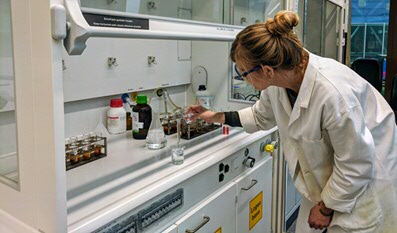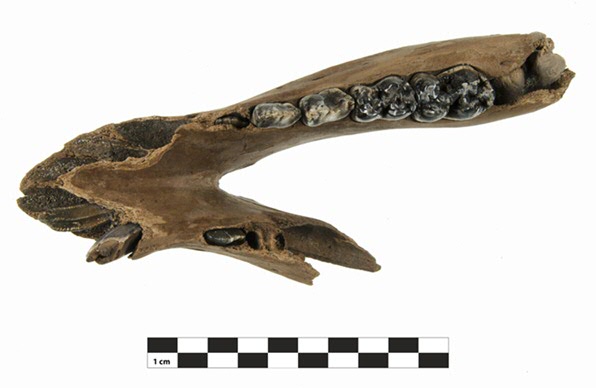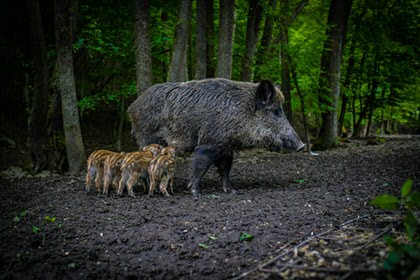Prehistoric wild boars had a plant-based diet
Research by zooarchaeologist Nathalie Brusgaard of the University of Groningen’s Faculty of Arts has revealed that prehistoric wild boars primarily ate plants. She is the first person in the Netherlands to have identified the diet of the wild boar by examining the chemical composition of its bones. The results of her research may help to determine more accurately the moment when humans switched from hunting to animal husbandry. Brusgaard’s findings were published today in the scientific journal PLOS ONE .
Around 5450 BC, people lived a nomadic lifestyle in small groups. Some of these groups spent the winter in what is now the Alblasserwaard, a region of Netherlands located in the provinces of Zuid-Holland and Utrecht. Those who settled there were part of the Swifterbant culture, which covered a large part of the Netherlands and extended into parts of Germany and Belgium. Numerous sites of this culture, rich in artefacts, have been uncovered in the Netherlands, including near Hardinxveld-Giessendam, where a great deal of archaeological research has already been carried out.

Studying the wild boar
But while many studies focus on prehistoric people, Brusgaard set her sights on the prehistoric wild boar that roamed the earth at the time when humans switched from hunting and gathering to animal husbandry. ‘That transition was a complex and lengthy process lasting perhaps 1,000 to 1,500 years – although that duration is still debated among archaeologists,’ Brusgaard says.
How big were wild boars?
One thing they do agree on is that the prehistoric humans who lived some 7,500 years ago survived by hunting and gathering. They hunted adult wild boar, among other things. Brusgaard: ‘As part of my research, I measured the bones of prehistoric boar to calculate their size. So we now know that these animals were as big as the wild boar found in Russia today. They are the biggest in Europe, weighing about 300 kilograms.’Changing hunting habits
Around 5000 BC, humans gradually started to change their habit of moving around from place to place; they stayed in the same area for several seasons. Their hunting habits also changed. ‘They stopped hunting adult animals that mainly lived alone and started hunting younger animals that lived in groups,’ says Brusgaard. This shift in behaviour may reflect human changes: perhaps the young animals were easy prey, or there was a need for more meat. ‘But it is equally possible that it was the wild boar that changed their behaviour, for example, in response to the presence of humans or a change in the environment. Perhaps this forced humans to change the way they hunted.’
Swimming from island to island
The area where wild boar lived some 7,000 years ago was quite large. Brusgaard: ‘They had a fairly large habitat in what is now known as the Alblasserwaard. It was an area with a lot of water and river dunes, which are little islands formed by sand deposits. They could swim and probably moved from island to island.’
A plant-based diet
Brusgaard researched the diet of the wild boar. Prehistoric wild boar mainly fed on plants that grew in forests and open landscapes. To determine this, Brusgaard used a method involving stable isotopes, which had not previously been used in the Netherlands for investigating the diet of the wild boar. ‘I’m working on this in collaboration with colleagues at the Faculty of Science and Engineering. In the lab, we chemically extract collagen from bone and measure the amount of carbon and nitrogen we find in it. The carbon indicates a plant-based diet, the nitrogen tells us about the animal’s position in the food chain.’

What does the diet tell us?
Brusgaard believes that determining the diet of wild boar is an important basis for subsequent research. ‘The next step is to examine pig bones from a slightly later period using the same chemical technique to determine the diet of these pigs and to compare it with that of the wild boar. We know that domestic pigs in the prehistoric era often ate humans’ food waste, which also contained meat or fish. So, their diet differed from that of the wild boar.’ Brusgaard hopes that her new research will enable her to more accurately determine the moment at which humans started keeping animals. ‘This ultimately led to people staying in the same place. This transition marks a change in the way people lived.’
About the research
Brusgaard’s research is part of the project ‘ The Emergence of Domesticated Animals in the Netherlands’ (EDAN), on the domestication process of pigs and cattle, at the Groningen Institute for Archaeology.
| Last modified: | 24 April 2024 2.11 p.m. |
More news
-
29 April 2024
Learning to communicate in the operating theatre
The aios operates, the surgeon has the role of supervisor. Three cameras record what happens, aiming to unravel the mechanisms of 'workplace learning'.
-
23 April 2024
Studying depopulation also means studying the history of those who stay
Assistant professor Yuliya Hilevych from the Faculty of Arts researches regional depopulation in the Netherlands, Finland, and Ukraine by placing the phenomenon in a social-historical perspective.
-
22 April 2024
Trump or no trump, that is the question
UG researchers Ritumbra Manuvie, Pieter de Wilde, and Lisa Gaufman look ahead to the elections in India, Europe, and the United States, respectively. This week: Lisa Gaufman.
